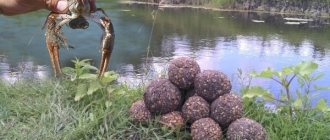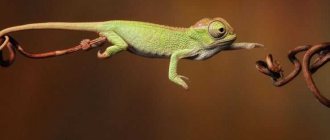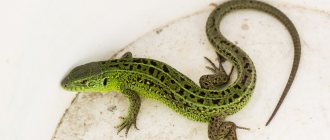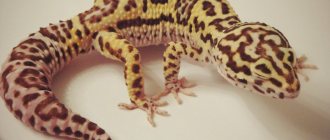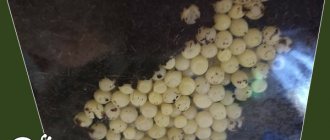Lizards are amazing reptiles. Most species (and there are more than 3,800 of them) are predators. Only a few are so-called “vegetarians”. Despite the fact that they are predators, for the most part they do not pose any threat to humans. Moreover, they can even become a true friend. It is for this reason that people often keep them at home, in specially equipped aquariums. And in today’s article we would like to talk about what lizards eat at home, in the wild, and what they should not eat.
Sandy lizard in nature
To avoid problems keeping this exotic animal at home, you need to know about its environment and living conditions. When walking in the forest, many see these nimble lizards, which are green or brown in color. They quickly hide in the grass or bushes if they notice danger. This species is called nimble lizards.
They are very common in Russia and are found in many areas. For this reason, the habitat also varies . These can be swampy areas of the territory, forests, steppes, dry rocky places. The main time of activity for fast lizards is during the day. It can move both on the ground and climb trees and rocky slopes.
This type of lizard, settling in the territory, sometimes digs a narrow hole for living. When they go hunting, they do not run more than 20 meters from the hole. This allows them, sensing danger, to quickly return to their shelter. The size of the sand lizard can vary.
Depending on the subspecies, the length varies from 5 to 25 centimeters. Females are usually slightly smaller than males and have less bright colors. The belly of females has a white or yellowish tint, while that of males is greenish-yellow.
If you suddenly grab such a wild lizard by the tail, it will try to bite, and then throw off the tail and disappear from sight. In such cases, they do not bleed, because the muscles in the place where the tail is folded back contract sharply.
After some time, a new tail grows. But in most cases it is already a little shorter than the previous one. This feature is important to consider if you keep an animal at home.
Brittle spindle (spindle)
No, it's not a snake at all. We have already told you in detail which snakes are found in central Russia.
In the photo there is a spindle, albeit legless (or rather, pseudo-legged), but a completely real lizard, which may well settle on your site if there are snags, rodent burrows, bales of compressed hay or shaded, damp places where it prefers to hide during the day.
The spindle leads a secretive lifestyle, is active at dusk and at night, and hides most of the time. But in the spring, after hibernation, it can often be found basking in the sun on a sandy path or lawn. The lizard goes to wintering until the end of September.
This is a completely harmless and very useful animal for the garden plot. The legless lizard feeds on earthworms, terrestrial mollusks, in particular, naked slugs, centipedes, woodlice, as well as insects and their larvae.
In some regions of Russia, the spindle is listed in the Red Book.
Outwardly, it is a densely built “snake” 40-50 cm long, brown or bronze in color with a light belly and absolutely no “neck” - this, along with movable eyelids, is its main difference from snakes. Males may have rows of dark spots or stripes on their backs. Eyes with round pupils. Like many lizards, the spindle can throw off its tail.
Young lizards are born in early June - the female brings from 3 to 26 cubs 38-50 mm long. Babies are born in a transparent egg shell, which they immediately tear and crawl in different directions - this process is called ovoviviparity. Immediately after birth, lizards are mobile and independent.
Spindles are quite slow and completely non-aggressive; they can be picked up without fear and even tamed. Unfortunately, because of its harmlessness, this reptile very often falls under the “hot hand” of poorly educated people.
Creating a terrarium at home
a terrarium specially created for this purpose . A lizard running freely at home can be injured. There are no rules as such for the size and shape of a home.
There are only some restrictions inherent in their habits. The height of the walls should be at least twice the length of the amphibian. This is because they can easily climb vertical planes.
As a material, you can choose glass from an old aquarium. The top cover should be made of wire mesh. There should also be holes for ventilation in the side walls. Some people make a terrarium out of an old book shelf.
In this case, ventilation holes are made in the top cover and side wall. The bottom is covered with soil. For example, coarse sand, pebbles or ordinary soil. It is advisable the interior of the terrarium with branches, pieces of wood, slides and small caves. The wild lizard will love it.
When keeping a lizard at home, the terrarium should have two temperature zones. In the so-called cold zone it should be no more than 30 degrees, and in the hot zone about 36 degrees.
An important point to consider is that if a reptile appears healthy but refuses to eat, this is not necessarily the cause of any illness. It is quite possible that she is not comfortable with the ambient temperature or has decided to have a fasting day. This is normal .
Types of lizards
Based on the type of food consumed, lizards are divided into three types: carnivores, herbivores and omnivores. True, in the wild the division into species is often very arbitrary.
It is quite possible to find a sand lizard that has a mixed diet. She will not refuse fruits and vegetables, as well as insects and small mammals. Despite this, you should consider each type of food separately in order to understand what to feed your lizard at home.
Carnivores or meat eaters
The following food is suitable as food for this species:
- Insects,
- worms,
- fish,
- cockroaches,
- snails
This species is very picky about food and feeding it at home will not cause any difficulties. But the cost of food will be directly dependent on the quality of food and the size of the reptile. The main food source should be insects, flies, locusts, worms, grasshoppers and cockroaches.
If the size of the lizard requires larger food, then you can sometimes treat it with small mice, rats or frogs. Before feeding such food, it is recommended to give rodents an injection containing vitamins and calcium. Thus, the reptile’s body will be additionally enriched with calcium after it eats this rat or small mouse.
You can offer simple meat or fish from time to time. But in this case, be careful. Before you give your lizard a treat, it is important to make sure that there are no parasites in the food. If you do not follow this rule, there is a high risk of infecting your reptile with intestinal disease.
Stick to the fact that everything should be in optimal quantities. Don't give too much meat or fish. And before giving such food, it is necessary to remove cartilage from meat and remove bones from fish.
Snails are the best food option for reptiles at home. It is very easy to breed this food. And thanks to the saturation of snail shells with calcium, this product is simply irreplaceable for almost all types of lizards.
It is not without reason that the diet recommended by veterinarians contains various sources of calcium: cuttlefish shells, egg shells and others.
Nutrient mixture and fertilizing
On your own, you can prepare a nutrient mixture that lizards really like. For this you will need meat and carrots (1:1). The meat needs to be ground in a meat grinder and the carrots grated. Next, mix it all, add a little lettuce leaves, calcium, and vitamin supplements. The nutritional mixture is ready.
Vitamins and minerals are necessary for the health, bright appearance, vigor and liveliness of lizards. They are not given in pure form, but must be mixed with food.
Most often, raw crushed eggshells, calcium glycerophosphate tablets, chalk and specialized preparations for reptiles are used.
Herbivores or herbivores
The main type of food for this type of lizard is various fruits and vegetables, for example:
- Grape,
- carrot,
- cabbage,
- apples,
- lettuce leaves,
- potato.
However, it is allowed to give these products in mixed form. But when feeding potatoes, be careful, as this product contains many different nitrates. Before treating your pet, peel the skin of such food and cut into small pieces.
When eating food occurs, carefully watch the lizard and try to understand its taste preferences. Subsequently, it will be possible to take into account her tastes when thinking through her diet.
, offer every two weeks . Predators need to be given plant foods.
Vegetarian food
For those who have a vegetarian pet, finding and serving food is easier. Food can be placed on a dish that is placed in the terrarium
or into the dishes already there. The frequency of feeding vegetarians, as well as the timing, depends on the type of animal, its size and activity.
Bearded dragons sometimes cling to three legs and use their free paws to make a sort of wave, twisting their paws and making small circles in the air. This behavior is believed to signify submission, as dragons typically only do this after being groomed or in response to other dragons in the higher hierarchy.
Shake your head vertically
This behavior is more common among male bearded dragons and is usually accompanied by the display of a beard. These movements are performed quickly and sharply, meaning they move the head up and down quickly. This movement is more pronounced during the breeding season. It means dominance; women tend to shake their heads in submission, gesture slower, and do not have the same spontaneity as men.
But you should not think that keeping a lizard that eats plant foods is very simple. Leaves of one green salad
can't get by here. Even vegetarian reptiles need nutrients. Therefore, you should diversify your pet’s diet whenever possible.
- Wild herbs are well suited for feeding vegetarian lizards: leaves and flowers of dandelion, nettle, clover, alfalfa, thistle, wheat germ.
- Vegetables: zucchini, pumpkin, cucumbers, carrots. Don't forget that durum varieties are served grated.
Monitor the quality of what your pet eats. It is best to use native or organic products that do not contain various chemicals. The greens offered must be thoroughly washed.
Climb onto the back of another dragon
This is rather an assertion of hierarchy and dominance, you need to be attentive to this behavior, because it can accommodate a group of dragons, in the case of laying several, and a dragon that can suffocate under it.
This behavior is characteristic of several reptiles. Just like showing off a beard, you also want to intimidate, and we can consider this behavior as a warning. The bearded dragon raises its tail a lot when it does not feel safe, when it is suspicious, characteristic of the vigilance of this species. This attitude can also be observed in females during mating and serves to indicate a male who is ready to mate.
Although some species of lizards readily eat dried vegetables, they need to be fed fresh, green foods. This is how reptiles get
required amount of liquid.
As for water, the lizard’s body has a good supply of fluid. Therefore, you can water them only once a day.
Show beard
Bearded dragons display a goatee when they feel threatened, through a bone impulse: they stretch the skin of the throat, which immediately turns black, thus taking in more ferocious air to try to intimidate.
This behavior is uncharacteristic, but dragons do it to stretch the skin of that region and often to facilitate replacement of skin in the same area. If your dragon exhibits this behavior, fear not. Bearded dragons are animals, so they can sometimes bite each other or even bite their owner. We must not forget that they are reptiles and that there are always days when the dragon can be more temperamental. Respect the animal but never show fear of it, it is important that the bearded dragon understands that the one who is dominant is you.
Omnivores
Sticking to this type of diet is quite easy. You can feed wild lizards with all the food that is listed above for both predators and herbivores. But under no circumstances should you feed your reptile regular human food.
Their body is not adapted to such food and therefore the consequences can be unpredictable. This can lead to both poisoning and serious illness.
It is important to remember that these are cold-blooded animals. If the ambient temperature drops below 20 degrees, they will refuse to eat. For this reason, their terrarium must have a thermometer to monitor the temperature.
Feed your lizard at intervals every day. But if she refuses to eat, try reducing her meals to once every two days. If appetite does not return within a week, contact your veterinarian.
Gourmet food
Some species of lizards, for example, tiliqua, love natural food. And for others, snails are a delicacy (for example, giant lizards
or spiny-tailed skinks). Since these skinks are quite large members of their family, they can crack large shells with their jaws. Young animals should be offered small snails. If there is no snail of a suitable size, you can crack the shell of a large snail and also give it to a young individual.
All reptiles are cold-blooded animals, so they need to be thermally regulated, and sometimes, to do this, they must adopt this behavior, similar to larger reptiles such as crocodiles. It serves to expel excess body heat. Bearded dragons are endowed with various physical characteristics, among them their coloring or phase. The phase is at the bottom of the drawing, which distinguishes each copy.
There are many different stages, so it is impossible to explain all the stages in this article. In short, we can say that through genetics one can determine the phase. Science has also allowed genetic manipulation of bearded dragons to create new phases. The image below shows some representative images of the phases most commonly known in bearded dragons.
There are reptiles, especially some types of gecko, that love sweet foods. In nature, they lick overripe fruits and eat nectar. These species can be offered fruit pulp
(bananas, oranges) in small bowls that are placed on the ground or the top of terrariums. It is important that the gecko is not offered sweet food components too often, as lizards tend to become obese.
Adult dragons are easier to sex because males have very different characteristics from females: they are wider and have longer heads. However, to be sure of your bearded dragon's sex, we can see ridges that are slightly higher than the glue. Bearded sex: male and female.
We must hold the bearded dragon in the palm of our hand, with its tail facing us, and carefully lift the beast's tail and inspect the area just above the ventral opening. These protrusions are noticeable from the age of three months. Males reach sexual maturity at around one year of age, while females are only required to reproduce until they are two years old.
Geckos like live food: spiders, flies, crickets. For larger reptiles, small mice are suitable. Interesting feature
: The larger the gecko, the less often it needs to be fed. For example, a lizard that has reached 20 cm in length is fed twice a week.
Other lizards, such as monitor lizards, prefer ready-made food to live food. They feed on rats, hamsters, dead chicks, poultry hearts, and even commercial dog and cat food.
If the bearded dragons are in good condition, simply join them in a wide area. There must be a place where the woman can leave the eggs. The female digs a hole for the eggs, then collects them and closes them. Bearded dragons can be housed individually, in pairs, or in groups of women.
The composition of the terrarium should provide the most comfortable and natural environment possible. Remember that this species has its origins in the Australian deserts, characterized by high temperatures and a very dry environment. The following measures are recommended as minimum dimensions.
How to feed a lizard
Young lizards are fed using tweezers. With its help, pets are given larvae, worms and all other living creatures. Since lizards love to climb trees, place food on the branches or on the high ground of the terrarium .
Some are diurnal, while others are nocturnal. Feed them during peak activity hours. Be sure to remove all leftover food. Many people like to drink water from the leaves of plants, while others will do just fine with a regular bowl of water. Monitor the water so that it is always fresh and clean.
If you got a lizard that was only recently born, then it still needs to be taught to eat. To do this, carefully grab the pet with one hand and use tweezers to move the larva over its mouth with the other. The reptile, licking itself, will begin to understand that this is food and will learn to eat on its own .
Please note that these are general guidelines. After you choose a specific type of lizard that you want to keep at home, read the information about caring for that particular species.
Content
What to feed your lizard?
What to feed a regular caught lizard?
Choosing food for lizards
What to feed your lizard?
Lizards are cold-blooded animals, which we consider to be predators. The life of lizards at home is very different from the life they live in the wild. But they are picky and unpretentious. If you don’t like to deal with your pet too often, but would like to have an interesting neighbor nearby, then buying a reptile is the best solution for you. These animals absolutely do not need communication with their owners; all they are interested in is a spacious aquarium, as close as possible to natural living conditions and the constant availability of the necessary food.
So, if you see a lizard at home with your friends, most likely you will also want to become the owner of such an unusual and exotic animal. After all, a reptile is not a cat or a dog that is encountered by every third neighbor.
To keep a lizard at home, you need to thoroughly prepare for your purchase, find out what you can feed it, what you can’t, where to get food, and create the right diet.
In general, there are three groups of lizards:
Accordingly, the feeding ration must be compiled not only based on the individual characteristics of the animal, but also taking into account the species to which it belongs.
The diet of lizards in nature consists of living creatures, less often plant foods. They love to eat various mammals, fish, amphibians, birds, and snakes. As you can see, the food of lizards in natural conditions is quite diverse.
How many times a day or how often should you feed your pet? Newborns need to be fed using forceps. Captive lizards need to be fed during their most active periods (there are diurnal and nocturnal reptiles). Water is very necessary for these pets. They either lick it off the leaves or drink it directly from the drinking bowl.
People often wonder how long a reptile can live without food in a terrarium. After all, sometimes you have to leave, and there may be no one to look after the reptile. So, you should take into account that this animal is unlike a domestic spider, which can sit without food for many days. Reptiles must eat several times daily (three in summer, two in winter). Cubs, and often adult lizards, are fed with various supplements and home-made mixtures. As for plant food, reptiles can periodically consume the following:
- greens (lettuce, parsley, spinach, clover);
- cabbage;
- broccoli;
- zucchini;
- toy apples;
- carrots;
- citrus;
- melon;
- grape.
